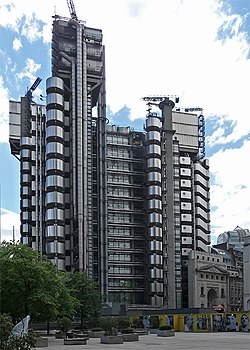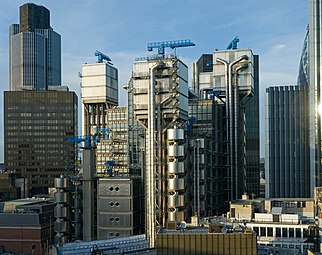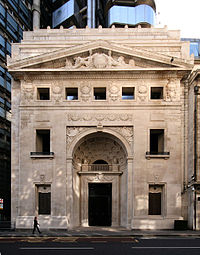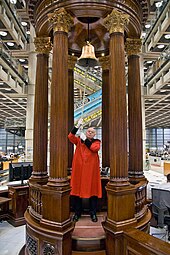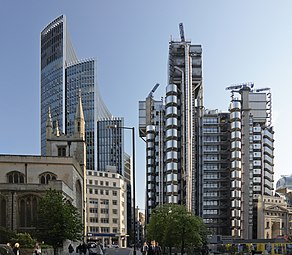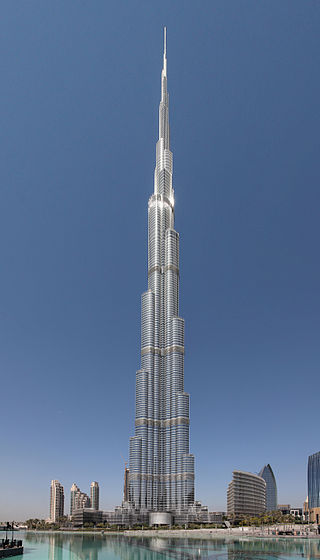
A skyscraper is a tall, continuously habitable building having multiple floors. Modern sources currently define skyscrapers as being at least 100 meters (330 ft) or 150 meters (490 ft) in height, though there is no universally accepted definition, other than being very tall high-rise buildings. Historically, the term first referred to buildings with between 10 and 20 stories when these types of buildings began to be constructed in the 1880s. Skyscrapers may host offices, hotels, residential spaces, and retail spaces.

The John Hancock Center is a 100-story, 1,128-foot super tall skyscraper located in Chicago, Illinois. Located in the Magnificent Mile district, the building was officially renamed 875 North Michigan Avenue in 2018.

Richard George Rogers, Baron Rogers of Riverside, was a British-Italian architect noted for his modernist and constructivist designs in high-tech architecture. He was a senior partner at Rogers Stirk Harbour + Partners, previously known as the Richard Rogers Partnership, until June 2020.

St Helen's is a commercial skyscraper in London, United Kingdom. It is 118 metres (387 ft) tall and has 23 floors. The postal address is No. 1, Undershaft, though the main entrance fronts onto Leadenhall Street, in the City of London financial district.

Leadenhall Market is a covered market in London, England, located on Gracechurch Street but with vehicular access also available via Whittington Avenue to the north and Lime Street to the south and east, and additional pedestrian access via a number of narrow passageways.

Fenchurch Street is a street in London, England, linking Aldgate at its eastern end with Lombard Street and Gracechurch Street in the west. It is a well-known thoroughfare in the City of London financial district and is the site of many corporate offices and headquarters. The name "Fenchurch" means "church in the fenny or marshy ground" and presumably refers to St Gabriel Fenchurch, which stood at the junction of Fenchurch Street and Cullum Street until it was destroyed by the Great Fire.

122 Leadenhall Street, which is also known as the Leadenhall Building, is a 225-metre-tall (738 ft) skyscraper in central London. It opened in July 2014 and was designed by the Rogers Stirk Harbour + Partners; it is known informally as The Cheesegrater because of its distinctive wedge shape similar to that of the kitchen utensil with the same name. It is one of numerous tall buildings recently completed or under construction in the City of London financial district, including 20 Fenchurch Street, 22 Bishopsgate and The Scalpel.
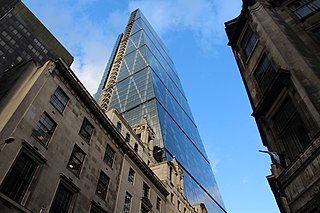
Leadenhall Street is a street in the City of London. It is about 1⁄3-mile-long (0.54 km) and links Cornhill in the west to Aldgate in the east. It was formerly the start of the A11 road from London to Norwich, but that route now starts further east at Aldgate.

The Willis Building is a commercial skyscraper in London named after the primary tenant, Willis Group. It is located on Lime Street in the City of London financial district.

88 Wood Street is a commercial skyscraper in London, located on Wood Street in the City of London.

East India House was the London headquarters of the East India Company, from which much of British India was governed until the British government took control of the company's possessions in India in 1858. It was located in Leadenhall Street in the City of London. The first East India House on the site was an Elizabethan mansion, previously known as Craven House, which the Company first occupied in 1648. This was completely rebuilt in 1726–29; and further remodelled and extended in 1796–1800. It was demolished in 1861. The Lloyd's building, headquarters for Lloyd's of London, was built on the site of the former East India House.
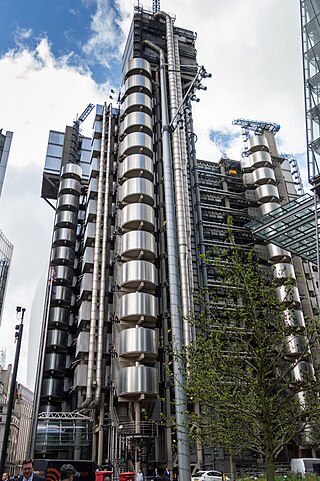
High-tech architecture, also known as structural expressionism, is a type of late modernist architecture that emerged in the 1970s, incorporating elements of high tech industry and technology into building design. High-tech architecture grew from the modernist style, utilizing new advances in technology and building materials. It emphasizes transparency in design and construction, seeking to communicate the underlying structure and function of a building throughout its interior and exterior. High-tech architecture makes extensive use of aluminium, steel, glass, and to a lesser extent concrete, as these materials were becoming more advanced and available in a wider variety of forms at the time the style was developing – generally, advancements in a trend towards lightness of weight.

RSHP is a British architectural firm, founded in 1977 and previously known as the Richard Rogers Partnership which became Rogers Stirk Harbour + Partners in 2007. The firm rebranded from Rogers Stirk Harbour + Partners to simply RSHP on 30 June 2022, after the retirement and death of Richard Rogers. Its main offices are located in the Leadenhall Building, London, completed to the firm's designs in 2014. Previously they were at the Thames Wharf Studios. In its various incarnations it has designed many important buildings including the Lloyd's building and the Millennium Dome in London and the Senedd building in Cardiff.

20 Fenchurch Street is a commercial skyscraper in London that takes its name from its address on Fenchurch Street, in the historic City of London financial district. It has been nicknamed "The Walkie-Talkie" because of its distinctive shape, said to resemble a walkie-talkie handset. Construction was completed in spring 2014, and the three-floor "sky garden" was opened in January 2015. The 38-storey building is 160 m (525 ft) tall. Since July 2017, the building has been owned by Lee Kum Kee Groups.
Bowellism is a modern architectural style heavily associated with Richard Rogers. It is described as a transient architectural and flippant style that was influenced by Le Corbusier and Antoni Gaudi. The style consists of services for the building, such as ducts, sewage pipes, and lifts, being located on the exterior to maximise space in the interior.

Lime Street is a minor road in the City of London between Fenchurch Street to the south and Leadenhall Street to the north. Its name comes from the lime burners who once sold lime from there for use in construction.
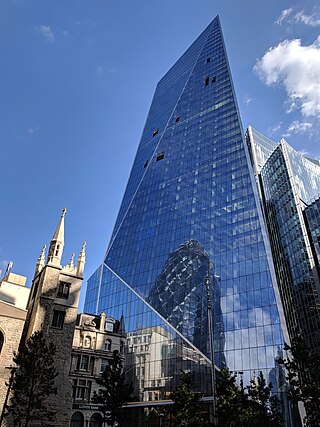
The Scalpel is a commercial skyscraper in London, United Kingdom. It is located on Lime Street in the City of London financial area. Originally a nickname but subsequently designated as its official name, the term "Scalpel" was coined by the Financial Times due to the building's distinctive angular design. The building has also been noted for its similarity to a "play" media button due to how it looks from South of the River Thames. This follows a trend of nicknaming new buildings based upon their shape, such as the nearby Leadenhall Building, also known as "The Cheesegrater". Completed in 2018, The Scalpel at 52 Lime Street is 190 m (620 ft) tall, with 38 storeys. It was designed by Kohn Pedersen Fox.

The St Botolph Building is a commercial office in Houndsditch, central London, opened in 2011 and designed by Grimshaw Architects.
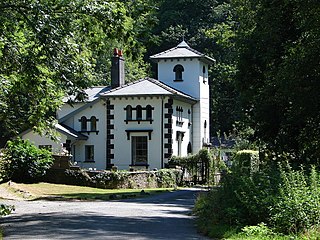
Richard Kyrke Penson or R. K. Penson was a Welsh architect and artist.
Graham Carl Stirk is an architect and senior partner at RSHP. He joined the Richard Rogers Partnership in 1983 and by 2007 the name of the practice changed to Rogers Stirk Harbour + Partners to reflect his contribution to the practice, along with Ivan Harbour, later renamed RSHP, after the death of Richard Rogers.
